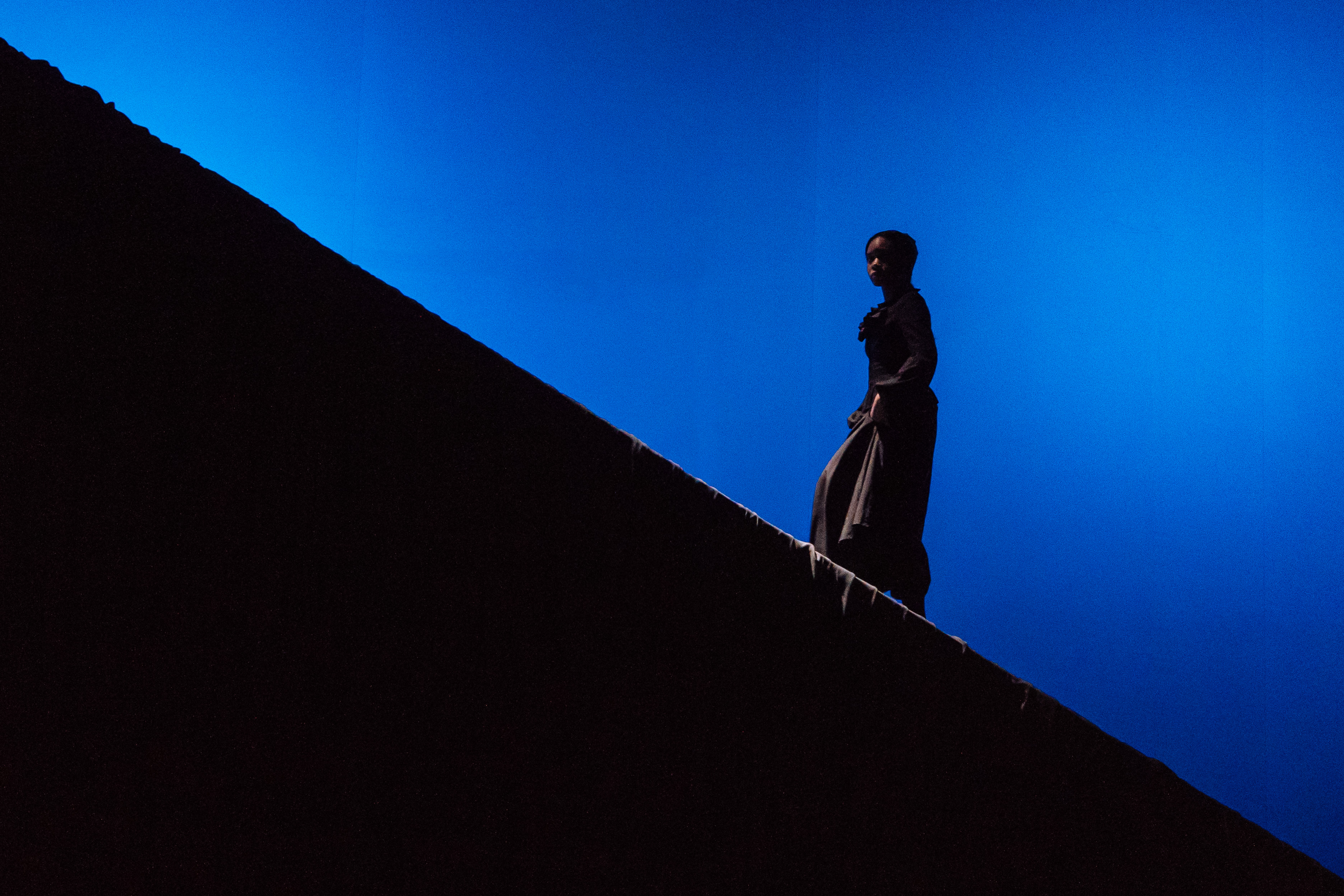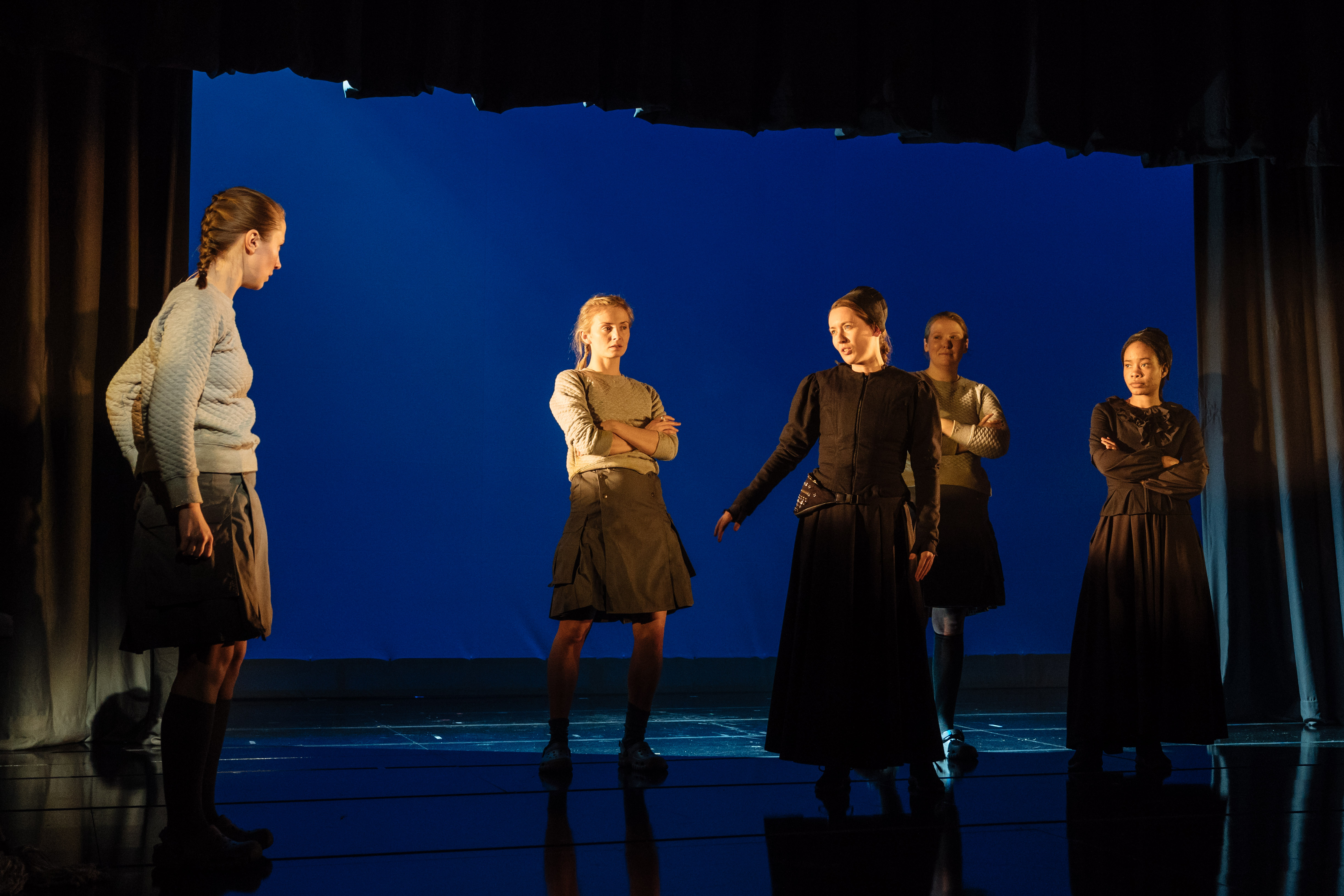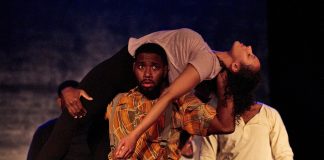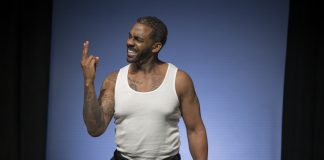On the face of it, this (almost four hour) play is a cross between The Handmaid’s Tale and Romeo and Juliet. Unfortunately, it doesn’t engage emotionally or thematically on the level necessary to justify comparison with either.
Writer Alan Ayckbourn has described his play as a “narrative for voices”, and that, early in the writing process, he thought of it as ‘a novel in dialogue form – a book’. This is made clear, by the device of using ‘Soween’ (Buffy Davis) to narrate her own childhood diary entries, before her younger self – and the rest of the cast – takes over, to enact scenes from a [fictional] bygone era.
Herein, we get told the story of a country divided by its [unseen] leader, ‘Preacher’, and his faux-religious cultural dogma. Preaching from the Bible-like “Book of Certitude”, women are taught that they are ‘born of sin’, are inferior to men, and that their main purpose is ‘the glorification of a male God’.
Erin Doherty, as the narrator/protagonist gives a committed, energetic and versatile performance
This is further emphasized – or utilised – when a ‘plague’ decimates the population’s reproductive protocols, causing a numerical decrease in male births. Blaming this epidemic on women, a gender-based apartheid is implemented. As a result, each citizen – once they reach a certain age – is processed and separated along gender lines: men in ‘The North’, and women to be kept back in ‘The South’.
From an early age, girls and boys are prepared for this separation. However, in order to keep society going, the girls know that, as women, they can apply to marry – and co-habit with – other females. Of course, it is understood that this is to be done only in order to raise a family under established conservative guidelines. To this end, one of the female partners must assume the subservient, nurturing ‘mama’ role, and the other must be the [patriarchal] ‘ mapa’ – and never the twain shall meet.
In this fictional dystopia, sex, sexuality, and /or expressions of personal desire are taboo. Indeed, heterosexuality is seen as deviant, and the marriage arrangement is imposed merely for societal expediency, rather than to create and uphold individual freedoms, or expressions of happiness. Furthermore, women are not allowed to be alone with grown males (shipped in from The North to assist with policing, teaching, etc.), show flesh, hair, dissent, or to wear bright colours.
There are allusions to Brexit (i.e. ‘vested interests’ taking advantage of ‘The Divide’), totalitarianism (no unauthorised books), the Cold War, American cultural migration, and to star-crossed lovers everywhere – I half-expected David Bowie’s “Heroes” to be played, at one point!
However, in the age-old theatrical tradition of combatting political and ideological dogma, quiet revolution is brought on by a public statue commemorating a personal sacrifice, a change of clothes to highlight communal recognition… and a couple of books written by the Bronte sisters!
If there are interesting ideas here (and there are), they could have been told with more brevity, alacrity and joy. It’s not to say that there aren’t moments of humour; some of the ‘asides’ are mildly funny. It’s just that the overall tone is austere and depressing.
Perhaps the premise of the piece is countermanded by its ‘bookending’ device; meaning that the regime has been toppled – and society righted – in the space of a lifetime. If we are reminded of anything in this Trump – and Brexit -dominated era, it’s that the battle for equality and fairness is hardly ever linear – despite our egos often failing to acknowledge life beyond our own existence.
Unfortunately, neither the storytelling, nor the direction does justice to the resources clearly available to the production
Erin Doherty, as the narrator/protagonist ‘Soween’, gives a committed, energetic and versatile performance. Even so, she is often undone by the story switching her character from ‘smart cookie’ to ‘dumb as dirt’ (and back again) in the blink of an eye.
[Rule of thumb: don’t have your hero be cleverer than everyone else one minute, miss the most glaring clues the next, and then still expect the audience to engage and empathise for a further 2.5 hours]
In a play charting community disparity and austerity, it was slightly diverting to be presented with a 13-strong main cast, a five piece band, and a 26 strong choir. Unfortunately, neither the storytelling, nor the direction does justice to the resources clearly available to the production.
It’s possible that the director was trying to make a point about ‘societal inequality through ostentation’, but I doubt it! Of course, if the play were better, the ‘bells and whistles’ would be a moot point; as it is, even the positive aspects of this production simply highlight the amount of time the audience has to sit through to the end.
From Christopher Nightingale’s evocative score, to Laura Hopkin’s versatile set – using projections, split-levels, ramps, stairways, curtains, and balconies – the (very capable) supporting cast are hamstrung by the plodding storyline, and the play’s bloated running time.
We are often told that strong storytelling must contain a beginning, middle, and an end. What a great shame that an editor wasn’t used here, to bring them all closer together.





























